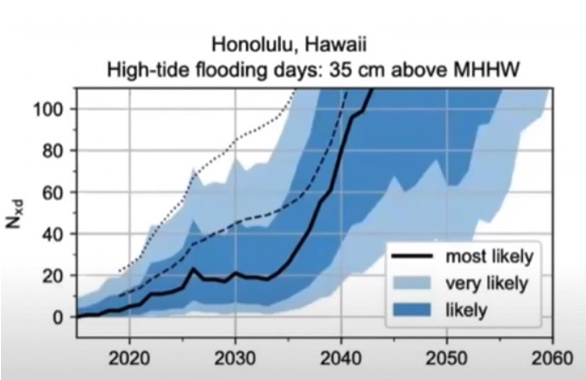By now, most people are familiar with the “hockey stick” phenomenon. That occurs when a trend that may have been bumping along at a gradual increase suddenly shoots skyward, going nearly vertical over a relatively short period.
It appears on graphic depictions of COVID-19 infections, for example, and on charts showing increases in carbon dioxide levels over time.
And it appears yet again in charts prepared by Dr. Phil Thompson, an oceanographer with the School of Ocean and Earth Science and Technology at the University of Hawaiʻi.
In particular, it shows up in forecasts Thompson has made of high-tide flooding events that Hawaiʻi can expect to see in years to come.
Thompson described his work in a webinar on coastal hazards sponsored by the UH Sea Grant program in July.
High-tide floods, Thompson explained, are not caused merely by extra-high tides. Rather, they are the result of a number of factors that can affect the sea level along the coast. This can include everything from low barometric pressure to ocean eddies, from warm ocean temperatures to seasonally high tides.
To create a flooding event, Thompson said, these factors can “stack” up. When that stack exceeds the mean higher high water mark (MHHW) by 30 to 40 centimeters, a high-tide flood can occur, causing roads and streets to flood, coastal areas to erode, and cesspools to leak, among other things.
“On an individual basis,” Thompson said, “one event perhaps doesn’t cause a great impact. But when many events occur, and their frequency increases, then we can start to have issues.”
Water levels have been measured hourly in Honolulu Harbor for more than a century, going back all the way to 1914. From these measurements, Thompson has been able to graphically show the gradual rise in high water levels over time.
Up until the late 1960s, there were no high-tide flood days at all (days in which water levels were 35 centimeters – about 14 inches — above the MHHW mark). In the entire decade of the 1990s, that level was exceeded fewer than 10 days.
But over the last five years or so, Thompson said, “you start to see much higher numbers.”
“2020 set a record, with 18 days above the threshold,” he said. “The impact is a little subtle, but there’s a general rise of sea level, slowly pushing more and more of those hourly water levels above the threshold. And we can expect to see more in the future.”
In years to come, high-tide flooding events will become more frequent, he said, but the frequency of these events “will not increase smoothly. Periods of little change will alternate with periods of rapid change.”
Over the decade of the 20s, the number of high-tide flooding days will likely remain under 20 per year, for most years. But the mid-2030s “marks the onset of a rapid increase” in the frequency of high-tide flood events. Mid-2030 marks a “really important tipping point for the whole state,” according to Thompson’s scenarios.
From the mid-30s to the start of 2040, under Thompson’s “most likely” scenario, the trend in the number of high-tide flooding days will take a sharp upward swing, going from around 20 such events per year to nearly 80. “The switch will flip” in the mid-30s, Thompson said. “Expect to see a quadrupling from 2030 to 2040.”
— Patricia Tummons


Leave a Reply